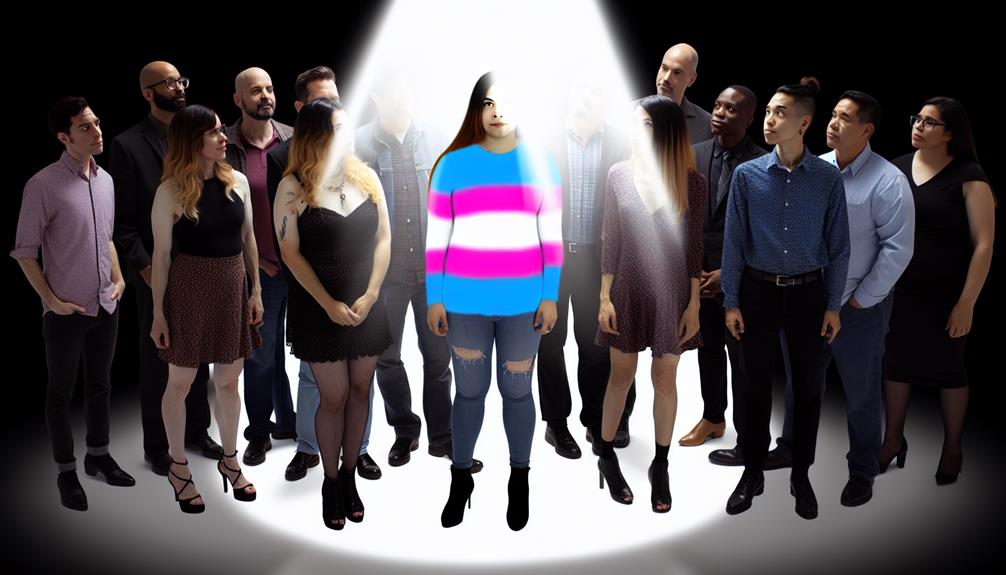Trans Visibility Challenges in Society


Table of Contents
ToggleThe struggle of trans and gender-diverse individuals encompasses a multitude of challenges, including pervasive discrimination, legal barriers, and social exclusion. Transgender and gender-diverse people often face high levels of violence and discrimination, with alarming rates of bullying, rejection, and employment discrimination. Their visibility in society brings with it a heightened vulnerability to these challenges.
This struggle is further compounded by the lack of legal recognition for their gender identity, which impacts various aspects of their lives, including access to healthcare, education, and employment opportunities. The visibility of transgender individuals has also been marred by negative portrayals in the media, contributing to their social exclusion.
The lack of legal recognition and the prevalence of employment discrimination create significant obstacles for transgender and gender-diverse individuals, hindering their ability to live authentically and access basic rights and opportunities. Their struggle for visibility and acceptance is an ongoing battle, and it’s crucial for society to address these challenges with compassion, understanding, and proactive measures to foster inclusivity and support for the transgender community.
Experiences and challenges faced by trans and gender-diverse individuals are profound, shaping their hopes for a more inclusive and accepting society. Many in the transgender and queer communities encounter discrimination, violence, and mental health struggles, with rates of depression, anxiety, and suicidal ideation being alarmingly high. Despite these challenges, there is hope for a brighter future, driven by the resilience and advocacy of the transgender community. Support groups play a crucial role in providing a sense of belonging and understanding, contributing to improved mental well-being.
The table below outlines key experiences, challenges, and hopes of the trans and gender-diverse individuals:
| Experiences | Challenges | Hopes |
|---|---|---|
| Discrimination | High levels of violence and discrimination | A more inclusive and accepting society |
| Mental Health | Increased rates of depression, anxiety, and suicidal ideation | Improved well-being and access to mental health resources |
| Support Groups | Limited access to supportive communities and resources | Enhanced support networks and sense of belonging |
Efforts to raise awareness, dismantle discriminatory policies, and foster understanding are essential to create a society where trans identities are respected and affirmed. It is vital to work collectively towards a future where all individuals, regardless of their gender identity, can live authentically and without fear of discrimination.
Experiencing challenges and discrimination, trans and gender-diverse individuals often face significant barriers related to legal gender recognition, impacting their access to fundamental aspects of their lives such as health, housing, and freedom of movement.
Legal gender recognition is the process through which individuals can have their gender identity officially acknowledged by official documents and records. This recognition is a fundamental aspect of a person’s identity and has a significant impact on various areas of life.
Unfortunately, many states impose burdensome requirements, such as medical certification, surgery, sterilization, or divorce, making the process difficult for trans and gender-diverse individuals. It’s crucial that legal gender recognition is based on self-determination, simple, accessible, cost-free, and inclusive of non-binary identities and minors.
States have an obligation to provide access to legal gender recognition in a manner consistent with human rights. It’s essential to recognize that a person’s gender identity may not align with the sex assigned at birth and that everyone deserves the right to have their gender identity legally recognized, in accordance with their human rights.
On Trans Day of Visibility, the global community comes together to celebrate and raise awareness about the experiences and contributions of transgender and non-binary individuals. This day serves as a platform for trans and non-binary individuals to be seen and heard, fostering understanding and acceptance. It also provides an opportunity for allies to learn about standing in solidarity with the transgender community.
The day aims to combat discrimination and promote positive and realistic representation of transgender and non-binary people, highlighting the diversity of their experiences globally.
One of the key challenges faced by transgender individuals is access to healthcare. Many trans individuals encounter barriers to receiving gender-affirming healthcare, including hormone therapy and surgical procedures. Additionally, transgender women, especially those of color, face disproportionately high rates of violence and discrimination. This day provides an opportunity to advocate for improved healthcare access and to address the systemic issues that contribute to the marginalization of transgender individuals.
Trans Day of Visibility is a crucial moment for promoting greater recognition and understanding of the diverse experiences of transgender and non-binary individuals, fostering a more inclusive and supportive society.
To understand and support the transgender community, it’s essential to acknowledge the diverse range of experiences and challenges they face. Transgender and nonbinary people navigate unique paths in relation to their gender identity, and it’s crucial to recognize and respect this diversity.
Visibility of trans individuals is a critical aspect of understanding and supporting the community. By amplifying their voices and experiences, society can gain insight into the challenges they encounter, including discrimination, violence, and mental health struggles.
Social security also plays a vital role in supporting transgender individuals, as access to healthcare, employment opportunities, and legal protections significantly impact their well-being.
Understanding the global perspective is equally important, as different cultural contexts present various challenges for transgender and nonbinary people.
The fight for trans visibility and acceptance is ongoing and crucial. It’s time for society to embrace and celebrate the diversity of gender identity. Allies and families must continue to educate themselves and support the transgender community. Together, we can break down the barriers and create a more inclusive world for all.
It’s time to TCB (Take Care of Business) and make a positive change.
Legal gender recognition requirements hinder access to vital services. Social inclusion efforts and addressing negative media portrayals are crucial.
Moreover, they face staggering rates of HIV infection and lack access to necessary healthcare. Understanding these challenges and advocating for inclusive and accepting environments is essential.
The estimated rates of detransitioning vary and aren’t extensively documented, making it challenging to pinpoint an exact frequency. Factors contributing to detransitioning may include external pressures, lack of support, or personal identity exploration.
It’s crucial to approach discussions about detransitioning with empathy, understanding, and support for individual experiences.
Enhanced research and open conversations within the transgender community can provide a more comprehensive understanding of detransitioning, aiding in better support and resources.
Gender dysphoria can feel like intense discomfort or distress with one’s assigned gender at birth. It manifests as deep unease and dissatisfaction with one’s body or social role, leading to emotional distress, anxiety, and depression.
Individuals may long for physical changes to align with their gender identity, and experience alienation and difficulty in social interactions. Understanding and supporting those experiencing gender dysphoria is crucial for creating an inclusive and accepting society.
Access to gender-affirming healthcare, including medical, legal, and social aspects, is crucial for a successful gender transition.
Social support and acceptance from families, classmates, and coworkers can reduce the challenges faced by trans and gender-diverse individuals.
Legal recognition of self-determined gender, through inclusive and non-discriminatory processes, positively impacts all aspects of a person’s life.
Sensitization campaigns, education policies, and positive media representation play a significant role in fostering the social inclusion of trans and gender-diverse persons.
 Featured PostsSeptember 17, 2025Beyond Coming Out: Trans Films That Break the Mold
Featured PostsSeptember 17, 2025Beyond Coming Out: Trans Films That Break the Mold News and AdvocacySeptember 16, 2025I Would Consider It: Trump’s Shocking Remark on Banning Pride Flags
News and AdvocacySeptember 16, 2025I Would Consider It: Trump’s Shocking Remark on Banning Pride Flags Trans Q&ASeptember 15, 2025Q&A – I’m Trans. What Do I Do Now?
Trans Q&ASeptember 15, 2025Q&A – I’m Trans. What Do I Do Now? Featured PostsSeptember 15, 2025Seeking Guidance From a Therapist Specializing in Gender Identity
Featured PostsSeptember 15, 2025Seeking Guidance From a Therapist Specializing in Gender Identity